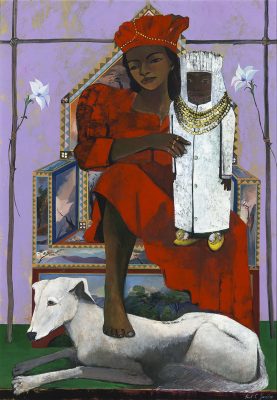 Paul Claude Gardère was born in Port-au-Prince, Haiti in 1944 into a family of Haitian “elite.” In 1958, at age fourteen, he moved to New York City with his mother and brother, the beginning of his life as an immigrant in the United States. He studied at The Art Student League (1960-61), completed a Bachelor of Arts degree at The Cooper Union School of Art and Architecture (1968) and earned a Master of Fine Arts from Hunter College (1972).
Paul Claude Gardère was born in Port-au-Prince, Haiti in 1944 into a family of Haitian “elite.” In 1958, at age fourteen, he moved to New York City with his mother and brother, the beginning of his life as an immigrant in the United States. He studied at The Art Student League (1960-61), completed a Bachelor of Arts degree at The Cooper Union School of Art and Architecture (1968) and earned a Master of Fine Arts from Hunter College (1972).
In 1978, Gardère returned to Port-au-Prince with his wife and young son to learn about his homeland and heritage as an adult. They remained in Haiti for 6 years, during which Paul painted intensely and exhibited at local galleries, The Musée d’Art Haitien, and Le Centre d’Art, and another child, a daughter, was born. It was during this period that Paul discovered his “true” artistic calling – to introduce Haitian art and culture into the broader scope of Western art history. Never having considered himself a traditionalist or legitimate regionalist artist, he began to introduce and adapt Haitian themes, painting styles, and cultural symbols to aesthetics of modern art.
In 1984, he relocated the family back to New York due to Duvalier’s rising antagonism toward the light-skinned and upper class in Haiti. The family took up residence in a worndown Brooklyn building which Paul rehabilitated and serves as the family home to this day.
Gardère went on to complete residencies at The Studio Museum in Harlem, the Jamaica Arts Center, Long Island University, and Claude Monet’s gardens in Giverny, France – a competitive opportunity afforded to him by the Lila Acheson Wallace Foundation. White the former was critical for his development as an artist of color in New York and his consideration of race and class, the latter was particularly influential for his exploration of post-colonial Franco-Haitian relations, politically and artistically. For his work, he received a fellowship from the New York Foundation for The Arts and won the Joan Mitchell Foundation Award for Painting. He was naturalized as an American citizen in 1996.
Gardère had solo shows at Le Centre d’Art, the Figge Art Museum, the Jersey City Museum and Skoto Gallery among others and exhibited in group shows in the US and Haiti. Mixed media works of his reside in the permanent collections of The Studio Museum in Harlem, The Schomburg Center for Research in Black Culture in NY, The Figge Museum, Zimmerli Art Museum, and others. Additionally, editions of his limited-run, handmade art book, “Upon A Time”, produced in collaboration with a poet friend, are owned by The Smithsonian American Art Museum, The Museum of Modern Art Library, the Brooklyn Museum Library, and several other estimable institutions.
A true diaspora artist, Gardère explored themes of exile and alienation, and his personal experiences of immigration, racism, and class in both countries drove much of the sociopolitical contexts referenced in his work. His work often addresses the tensions inherent to “belonging” in disparate social spheres and cultural groups, illustrated by the stark contrast between Euro-American and Afro-Haitian imagery, refined and rustic materials, and delicate and expressionistic painting styles. Gardère used symbols and wellknown visual references as a way of “metaphysical bridge building” across these divides, drawing inspiration from the canons of European art and Catholicism as well as classic Haitian painting and Vodou. In writing, he described, the “very real dilemma of carrying one culture internal while having to operate in another” and stated that the “concept of multiple narratives, a story with two or more points of view, is the operational principle of my work.”
Paul Gardère died in New York City in September 2011, only a few weeks after the passing of his wife of 42 years. Though the majority of his life was spent in the United States, Haitian life and culture remained the lens through which Paul explored the topics of post-colonial history, cultural hybridity, and the pluralistic and diasporic identities of the modern world. His original studio in Brooklyn is the center of his archives.
